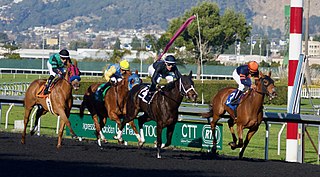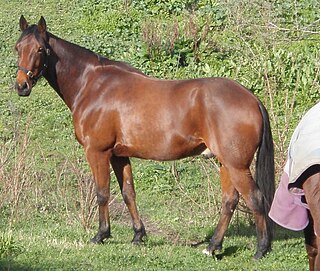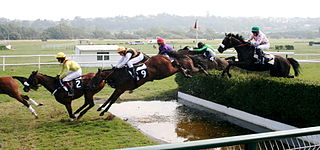
Thoroughbred racing is a sport and industry involving the racing of Thoroughbred horses. It is governed by different national bodies. There are two forms of the sport – flat racing and jump racing, the latter known as National Hunt racing in the UK and steeplechasing in the US. Jump racing can be further divided into hurdling and steeplechasing.

Equestrianism, commonly known as horse riding or horseback riding, includes the disciplines of riding, driving, and vaulting. This broad description includes the use of horses for practical working purposes, transportation, recreational activities, artistic or cultural exercises, and competitive sport.

Horse racing is an equestrian performance activity, typically involving two or more horses ridden by jockeys over a set distance for competition. It is one of the most ancient of all sports, as its basic premise – to identify which of two or more horses is the fastest over a set course or distance – has been mostly unchanged since at least classical antiquity.

Harness racing is a form of horse racing in which the horses race at a specific gait. They usually pull a two-wheeled cart called a sulky, spider, or chariot occupied by a driver. In Europe, and less frequently in Australia and New Zealand, races with jockeys riding directly on saddled trotters are also conducted.

The Standardbred is an American horse breed best known for its ability in harness racing where they compete at either a trot or pace. Developed in North America, the Standardbred is recognized worldwide, and the breed can trace its bloodlines to 18th-century England. They are solid, well-built horses with good dispositions.

Thoroughbred horse racing is a spectator sport in Australia, and gambling on horse races is a very popular pastime with A$14.3 billion wagered in 2009/10 with bookmakers and the Totalisator Agency Board (TAB). The two forms of Thoroughbred horseracing in Australia are flat racing, and races over fences or hurdles in Victoria and South Australia. Thoroughbred racing is the third most attended spectator sport in Australia, behind Australian rules football and rugby league, with almost two million admissions to 360 registered racecourses throughout Australia in 2009/10. Horseracing commenced soon after European settlement, and is now well-appointed with automatic totalizators, starting gates and photo finish cameras on nearly all Australian racecourses.
National Hunt racing is a form of horse racing particular to France, Great Britain, and Ireland, that requires horses to jump fences and ditches. In the UK it is divided into two major distinct branches, hurdling and steeplechase, as well as flat races called "bumpers". Hurdling involved the horses jumping over obstacles called hurdles, whereas in a steeplechase the horses jump over a variety of obstacles that can include plain fences, water jump or an open ditch. In the UK, the biggest National Hunt events of the year are generally considered to be the Grand National and the Cheltenham Gold Cup.

Skijoring is a winter sport in which a person on skis is pulled by a horse, a dog, another animal, or a motor vehicle. The name is derived from the Norwegian word skikjøring, meaning "ski driving". Although skijoring is said to have originated as a mode of winter travel, it is currently primarily a competitive sport.

A steeplechase is a distance horse race in which competitors are required to jump diverse fence and ditch obstacles. Steeplechasing is primarily conducted in Ireland, Great Britain, Canada, United States, Australia, and France. The name is derived from early races in which orientation of the course was by reference to a church steeple, jumping fences and ditches and generally traversing the many intervening obstacles in the countryside.

Harness racing, also colloquially known as trotting or the trots, is a spectator sport in Australia, with significant amounts of money wagered annually with bookmakers and the Totalisator Agency Board (TAB). In Australia there are 90 harness racing tracks, which hold over 1,900 meetings annually. There are approximately 2,900 drivers and 4,000 trainers with about 5,000 Standardbred horses foaled and registered each year.
The New Zealand Cup for standardbred horses, also known as either the New Zealand Trotting Cup or the New Zealand Pacing Cup is a Group One (G1) harness race held annually by the New Zealand Metropolitan Trotting Club at Addington Raceway in Christchurch, New Zealand.

Horse racing in Japan is a popular equestrian sport, with more than 21,000 horse races held each year. There are three types of racing that take place in Japan - flat racing, jump racing, and Ban'ei Racing.
Peppers Pride was an undefeated, multiple stakes winning American Thoroughbred race horse.

Charlottenlund is a suburban area on the coast north of Copenhagen, Denmark. It is the administrative seat of Gentofte Municipality. Bordered to the east by the Øresund, to the South by Hellerup and to the north by Klampenborg, it is one of the wealthiest areas in Denmark. The neighbourhood takes its name after Charlottenlund Palace.
Harness racing in New Zealand is primarily a professional sport which involves pacing and trotting competitions for Standardbred racehorses. The difference is the horse's gait or running style:
Horse racing in Wales has a long tradition dating back to the 18th century. Wales has held flat racing, National Hunt and harness racing, and presently has three racecourses, at Chepstow, Bangor-on-Dee and Ffos Las. The Welsh Grand National is held annually at Chepstow between Christmas and New Year and is the highlight of the Welsh racing calendar.
Charlie Mills was a German harness racing driver and trainer of an Irish descent.

Charlottenlund Racetrack is a harness racing track in the town of Charlottenlund in the Capital Region of Denmark.
Horse racing in the United States dates back to 1665, which saw the establishment of the Newmarket course in Salisbury, New York, a section of what is now known as the Hempstead Plains of Long Island, New York. This first racing meet in North America was supervised by New York's colonial governor, Richard Nicolls. The area is now occupied by the present Nassau County, New York, region of Greater Westbury and East Garden City.
Gallo Blue Chip is a Standardbred harness racing horse who earned $4.2 million in total winnings during his racing career. Gallo Blue Chip's sire was Magical Mike, and his dam was Camatross. Magical Mike's sire was Tyler B., and his dam was Racing Date; Camatross' sire was Albatross, and her dam was Bye Bye Camille.











